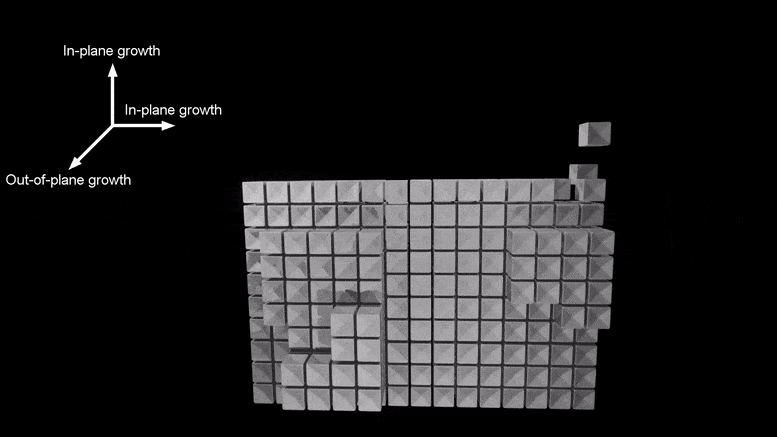
Researchers from Northwestern College and the College of Illinois, Urbana-Champaign, have seen nanoparticles self-assembling into forged fabrics for the primary time, providing precious insights for the design of latest fabrics, corresponding to skinny motion pictures for electronics. The charming movies display debris cascading, tumbling, and sliding into position, in the end forming a crystal’s function stacked layers. The groundbreaking find out about is printed within the magazine Nature Nanotechnology. Credit score: Erik Luijten and Qian Chen
First real-time glimpse into the expansion behavior of nanoparticles.
- Present in salt, sugar, snowflakes, and gems, crystals are extremely ordered, layered constructions
- Even if crystals are ubiquitous in nature, how they shape has remained a thriller
- The use of optimized microscopy, researchers have watched nanoparticles shape crystals in genuine time
- Researcher: “I will’t imagine we will see this. We’ve by no means observed the expansion activity sooner than.”
For the primary time ever, researchers have watched the enchanting strategy of nanoparticles self-assembling into forged fabrics. Within the shocking new movies, debris rain down, tumble alongside stairsteps and slide round sooner than in spite of everything snapping into position to shape a crystal’s signature stacked layers.
Led by means of Northwestern University and the University of Illinois, Urbana-Champaign, the research team says these new insights could be used to design new materials, including thin films for electronic applications.
The research will be published today (March 30) in the journal Nature Nanotechnology.
Animation illustrating in-plane and out-of-plane expansion modes for crystals of gold concave nanocubes inside of a liquid-phase transmission electron microscope (TEM) chamber. Credit score: Erik Luijten and Qian Chen
Described by means of the researchers as an “experimental excursion de power,” the find out about used a newly optimized type of liquid-phase transmission electron microscopy (TEM) to realize unparalleled insights into the self-assembly activity. Ahead of this paintings, researchers have used microscopy to observe micron-sized colloids — which can be 10 to 100 occasions higher than nanoparticles — self-assemble into crystals. Additionally they have used X-ray crystallography or electron microscopy to visualise unmarried layers of atoms in a crystalline lattice. However they have been not able to observe atoms for my part transfer into position.
“We all know that atoms use a equivalent scheme to collect into crystals, however we’ve got by no means observed the true expansion activity,” stated Northwestern’s Erik Luijten, who led the theoretical and computational paintings to provide an explanation for the observations. “Now we see it coming in combination proper in entrance of our eyes. Through viewing nanoparticles, we’re observing debris which might be higher than atoms, however smaller than colloids. So, we’ve got finished the entire spectrum of period scales. We’re filling within the lacking period.”
“Up to now, our crew resolved the thriller of nucleation, specifically how the embryos of crystals composed of tens of nanoparticles are shaped, which follows a nonclassical pathway in resolution,” stated Illinois’ Qian Chen, who led the experimental paintings. “With contemporary advances in liquid-phase TEM and knowledge science, on this paintings, we are actually in a position to seize and monitor motions of hundreds of nanoparticles over the years. Those nanoparticles wiggle in resolution and develop into crystals of quite a lot of morphologies like polyhedral or marriage ceremony cake.”
Liquid-phase TEM video of layer-by-layer expansion of a crystal with clean floor from gold concave nanocubes. Floor debris at the rising crystal are tracked (middle positions overlaid with yellow dots). Credit score: Erik Luijten and Qian Chen
Luijten is a professor of fabrics science and engineering at Northwestern’s McCormick College of Engineering, the place he is also an affiliate dean. Chen is an affiliate professor of fabrics science and engineering at Illinois.
The general public are acquainted with crystals within the varieties of salt, sugar, snowflakes, and glowing gemstones, corresponding to diamonds. Even if crystallization is a ubiquitous phenomenon, precisely how crystals shape has remained a thriller. The development blocks — atoms, molecules, or ions — that compose crystalline fabrics are extremely ordered, forming lattices of similarly spaced development blocks. Those lattices then stack on best of one another to shape a third-dimensional forged subject matter.
“The stacking of atoms into common preparations is the explanation that crystals have clean, flat faces,” Luijten stated. “That’s why they ruin alongside directly edges.”
Up till now, researchers have studied crystallization by means of analyzing a lot higher debris known as colloids. However observing colloids self-arrange into crystals didn’t give insights into how atoms behave. While crystals have flat, uniform surfaces, crystalline constructions created from micron-sized colloids generally tend to undertake non-uniform, tough surfaces.
“Colloids are such a lot higher than atoms that it’s in doubt they observe the similar steps when crystallizing,” Luijten stated. “So, they don’t educate us what atoms do. The analogy of colloids to atoms doesn’t actually hang.”
To glean deeper insights into the crystallization activity, Luijten, Chen, and their groups grew to become to nanoparticles. Fresh advances to reinforce liquid-phase TEM have made it conceivable to view nanoparticles in real-time as they shape forged fabrics. Chen’s crew spent years optimizing the method to verify the electron beam may view the debris with out destructive them. Within the new find out about, the researchers used another way formed nanoparticles — cubes, spheres, and indented cubes — to discover how form impacts conduct.
The researchers first visualized crystal formation with complex laptop simulations, that have been carried out by means of Northwestern graduate scholars Ziwei Wang and Garrett Watson in addition to postdoctoral fellow Tine Curk. Then they carried out experiments with liquid-phase TEM to observe the nanoparticles self-assemble in real-time. Within the experiments, the researchers spotted the debris collided into each and every different, sticking in combination to shape layers. Then, to shape the layer-by-layer crystalline construction, the debris first shaped a horizontal layer after which stacked vertically. Every so often, after sticking to one another, the debris in brief indifferent to fall onto a layer under.
“They run alongside after which hesitate on the edge sooner than falling,” Luijten stated. “It’s like a diver hesitating on the fringe of a diving board. I will’t imagine we will in reality see this. We’ve by no means observed the true expansion activity sooner than — most effective the outcome.”
Luijten stated this data will assist engineers design new fabrics. The perception particularly may assist with the design of thin-film fabrics, which can be steadily used to construct versatile electronics, light-emitting diodes, transistors, and sun cells.
“Realizing how debris come in combination will allow us to keep watch over the form of a floor,” Luijten stated. “Do you need a flat or tough floor? Converting particle form or how briskly the debris fall can have an effect on the skin.”
Reference: “Unravelling the crystal expansion of nanoparticles” 30 March 2023, Nature Nanotechnology.
DOI: 10.1038/s41565-023-01355-w
The find out about was once supported by means of the U.S. Division of Power (award numbers DE-SC0020723 and DE-SC0020885) and the Nationwide Science Basis (award quantity DGE-1842165).
Supply Through https://scitechdaily.com/watch-the-mesmerizing-process-of-nanoparticles-self-assembling-into-crystals/


